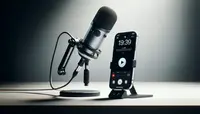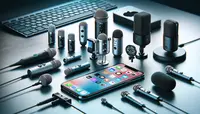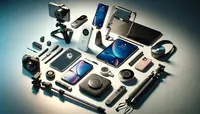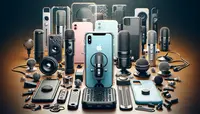The Best External Microphones for iPhone
I’ve been able to test many different external microphones while recording videos but also audio-only using my iPhones.
I know how hard it can be to choose the best of them, the one that fit you and your needs perfectly. This article will guide you through the 4 best external microphones that you can use on an iPhone, so your choice will be easier.
If you are wondering how to connect an external microphone to an iPhone, I’ve made a specific article explaining all that you need to know.
Best Overall: Rode VideoMic
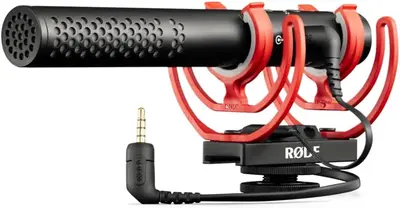
Pros
- Exceptional Sound Quality
- User-Friendly
- Long Battery Life
- Compact and Portable
Cons
- Additional Cable Required for iPhone
- Price
This Rode microphone is the best external microphone with an iPhone, if not the best portable microphone among all of them.
Key Features
- Compatibility: Works seamlessly with a wide range of devices, including iPhones, cameras, and computers.
- RF Rejection: The microphone features RF rejection, which effectively prevents interference, ensuring that your recordings are crystal clear.
- Shock Mount: It comes equipped with a shock mount, which is crucial for reducing handling noise and vibrations.
- Adjustable Output Levels: The VideoMic NTG offers a wide range of output levels, allowing you to fine-tune your audio recording according to your needs.
- Safety Channel Recording: This feature records a "safety channel" at a lower level, providing a backup in case the primary recording peaks unexpectedly.
Personal Experience
Using the Rode VideoMic NTG with my iPhone was a revelation. The setup was straightforward, and the quality of the audio recordings was exceptional. I particularly appreciated the RF rejection feature, which eliminated any worries about interference during outdoor shoots. The shock mount is a thoughtful addition, ensuring that my recordings were free from any unwanted noise.
The adjustable output levels were especially useful. I could easily adjust the settings to suit different recording environments, from quiet interviews to bustling street scenes. The safety channel is a standout feature; it gave me peace of mind knowing that I had a backup in case of any unexpected audio spikes.
In terms of performance, the Rode VideoMic NTG exceeds expectations. Its directional shotgun pattern is perfect for focusing on the subject while minimizing background noise. This makes it ideal for interviews, vlogs, and even musical performances. The audio captured is not just loud but also clear and rich in detail, enhancing the overall production quality of my iPhone videos.
To be honest, this is probably the best portable microphone I ever used.
Battery Life: Over 30 hours Frequency Range: 20Hz - 20kHz Output Connection: 3.5mm, USB-C Bit Depth: 24-bit Sample Rates: 48kHz
Cheap Option: SARAMONIC Vmic Mini 2
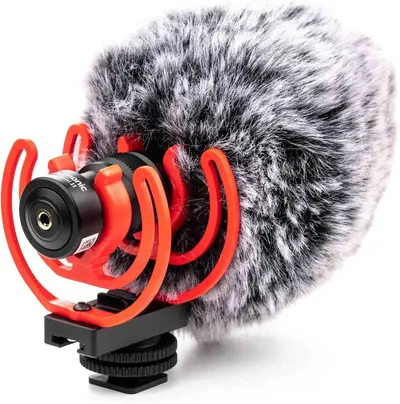
Pros
- Compact and Lightweight
- Broadcast-Quality Sound
- No Battery Required
Cons
- Directional Audio Capture
- Lacks Additional Features
Exploring the world of on-camera external microphones led me to the Saramonic Vmic Mini II, a compact yet powerful tool designed for a wide range of content creators. From mobile journalists to vloggers and run-and-gun shooters, this microphone promises broadcast-quality sound in a tiny package.
Personal Experience
Testing the Saramonic Vmic Mini II was a delightful surprise. Despite its small size, the audio quality it delivered was exceptionally clear and crisp. The cardioid polar pattern effectively isolated my voice while minimizing background noise, making it perfect for outdoor shoots and busy environments.
The dual Rycote Lyre Suspensions on the shock mount are a notable feature. They provided excellent stability, reducing handling noise and vibrations significantly. This was particularly useful when I used the microphone on a boom pole, as it remained steady and unaffected by movements.
The furry windscreen is another standout addition. It not only protected the microphone from wind and dust but also ensured that the audio remained clear even in challenging weather conditions. Its lightweight and rugged construction made it an ideal companion for outdoor recordings and on-the-go shooting sessions.
This external microphone is not as good as the Rode one, but it’s still a very good microphone, considering the price.
Type: Mini Shotgun Microphone Construction: Rugged aluminum alloy Compatibility: Smartphones and Cameras Mount: Adjustable Shock Mount
Best Lavalier: BOYA by-M1
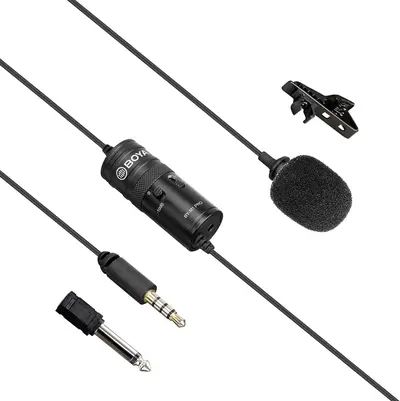
Pros
- Affordable
- Portability and Convenience
- 6-meters Long Cable
Cons
- Requires an LR44 battery
- Potential Cable Hazards
The BOYA by-M1 Pro Omnidirectional Lavalier Microphone stands out as a versatile and budget-friendly option. I recently had the opportunity to test this microphone in various settings, and I was impressed by its performance, especially given its affordability.
Key Features
- Versatility: Compatible with smartphones, DSLR cameras, camcorders, audio recorders, and PCs/laptops.
- Portability: The lightweight design and long cable make it ideal for various recording situations.
- Ease of Use: Simple setup and user-friendly features like the camera/smartphone switch.
- Recording Quality: Delivers clean audio for single-person recordings in quiet environments. Its omnidirectional pattern ensures sound is picked up equally from all directions.
Personal Experience
Using the BOYA by-M1 Pro was a straightforward and pleasant experience. Its lightweight and clip-on design made it incredibly easy to use during my mobile recordings. The long cable was particularly useful, allowing me to move freely without worrying about disconnecting the microphone.
The sound quality for single-person recordings was impressively clear, capturing my voice without any significant distortion or background noise. However, I did notice some limitations when using it in multi-speaker settings, as the omnidirectional pattern picked up sound from all around, leading to some unwanted background noise.
Weight: 2.5g Cable Length: 6 meters Connection: 1/8 inch 4-pole fold plug, with 1/4 inch adapter Additional Features: Foam windscreen, lapel clip, camera/smartphone switch.
Best Wireless: BOYA Wireless Lavalier
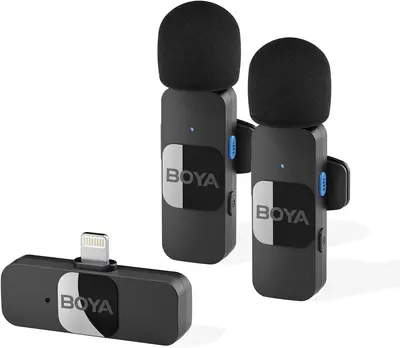
Pros
- Automatic Pairing
- Good Quality Audio
- MFi Certified
- Charge your iPhone while Recording
Cons
- Limited Battery Life
- Omnidirectional Pickup
In the pursuit of the best external microphones for iPhone, the BOYA Wireless Lavalier Microphone emerges as a standout contender. Designed for the modern content creator, this microphone offers a blend of convenience, quality, and versatility, ideal for a range of applications from podcasting to live streaming.
Key Features
- Easy Automatic Connection: No adapters, Bluetooth, or applications needed. The microphone pairs automatically upon activation.
- High-Quality Audio Solution: Offers clear sound recording, cutting off any noise interference, thanks to its high-sensitivity microphone and noise reduction technology.
- MFi Certified: Comes with a Lightning connector and a charging cable, making it compatible with iOS smartphones, iPad, and other Apple devices.
- Versatile Use: Ideal for interviewing, online conferencing, podcasting, vlogging, and live streaming.
- Charging While Recording: Features a USB-C charging port on the receiver, allowing you to charge your device during long recording sessions.
Personal Experience
Using the BOYA Wireless Lavalier Microphone was an absolute breeze. The automatic pairing process made the setup effortless, and the omnidirectional sound reception ensured that my voice was captured clearly, regardless of the environment. Its lightweight design was hardly noticeable when clipped on, making it perfect for extended use without any discomfort.
The sound quality was impressive, considering this is a wireless microphone. The microphone adeptly handles different recording scenarios, from quiet indoor settings to more dynamic outdoor environments. The ability to charge while recording was particularly useful during longer sessions, ensuring uninterrupted performance.
Connectivity: Wireless 2.4Ghz technology Frequency Range: 20Hz - 16kHz Sensitivity: -42dB Signal-to-Noise Ratio: 80dB Operating Range: 50m Charging Port: USB-C Transmitter Battery Capacity: 95mAh Weight: Transmitter: 9.5g, Microphone: 6g
What to consider before buying an External Microphone
When shopping for an external microphone for your iPhone, it’s crucial to consider several factors to ensure you get the best audio quality for your needs. Here's a guide to help you make an informed decision:
- Type of Microphone: Decide between shotgun, lavalier, or handheld mics. Shotgun mics like the Rode VideoMic NTG and Saramonic Vmic Mini II are great for directional audio, while lavalier mics like the BOYA models offer portability and ease of use.
- Connectivity: Check for compatibility with your iPhone. Lightning connectors or wireless options like the BOYA Wireless Lavalier ensure seamless connection. Keep in mind that wired Microphone usually provide a better audio quality compared to wireless ones.
- Sound Quality: Look for features like a high signal-to-noise ratio and a wide frequency response. The Rode VideoMic NTG, for instance, offers exceptional clarity.
- Usage Scenario: Consider where you'll be using the mic. If you're outdoors, you might need something with robust wind protection. For interviews, a lavalier mic might be more suitable.
- Portability and Durability: If you're often on the move, choose a compact and rugged mic, like the Saramonic Vmic Mini II.
- Battery Life: For wireless options, consider the battery life. The BOYA Wireless Lavalier, with about 9 hours of battery life, is suitable for long recording sessions.
- Budget: Determine your budget. While the Rode VideoMic NTG might be a premium choice for an external microphone, the BOYA BY-M1 Pro offers affordability.
- Additional Features: Look for extra features like automatic pairing, noise reduction technology, and charging while recording, as seen in the BOYA Wireless Lavalier.
FAQ
Do these external microphones work with all iPhone models?
Most newer iPhone models require an adapter for microphones with a 3.5mm jack. Wireless options like the BOYA Wireless Lavalier directly connect to iPhones with a Lightning port.
Can these external microphones be used for professional video recording?
Yes, microphones like the Rode VideoMic NTG are suitable for professional use due to their high-quality sound capture and advanced features.
How does a shotgun microphone differ from a lavalier microphone?
Shotgun microphones, like the Saramonic Vmic Mini II, are directional and capture sound from a specific direction, ideal for on-camera use. Lavalier microphones, like the BOYA models, are small, clip-on mics that offer more freedom of movement and are great for interviews.
How do I ensure the best sound quality when recording with an iPhone?
Use a high-quality external microphone, record in a quiet environment, and ensure the microphone is positioned correctly. Also, consider using a pop shield or windscreen for outdoor recordings.

